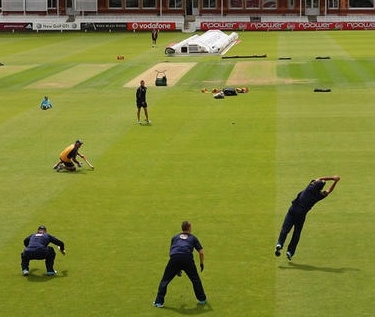|

How vital is a good slip catcher?
We work all year on developing bowling fast bowlers and spinners with the intention of taking the edge of the bat to create catching opportunities. So develop fielders who can convert those chances into wickets!
So, as a coach, lets assign some quality time to slip catching skills. Including your own. Read on to find out more:
Become a World Class "Nicker"
When I deliver fielding on ECB Level III and Level IV coaching courses, the first thing that I say is that we can not develop world class fielders without developing our own skills into our practices.
So get down and start practising nicking the ball into the slip cordon.

Like the photo shows, it's important to get down on your knees when nicking balls.
Most edges to slip from front foot defensive shots or drives. It's vital to nick the ball from the same height to functionally replicate the trajectory of the slip catch.
I get frustrated with coaches who do a slip drill from a standing position as they are not preparing their players optimally. Some of you will moan that you will feel vulnerable in a kneeling position against an oncoming cricket ball.
Well, get your helmet on and chest guard if needs be and crack on.
Find a confident thrower
The next thing is to find a fellow coach or player in your squad with a good arm. Then start to work on your throw-nick partnership.
It's important that you have confidence in your thrower. You need to calibrate by having the ball reach you with consistent pace and consistent accuracy. Remember, it's a skill to develop any partnership so be patient, work hard and the results will come.
Stand how you want
The coaching of batting stances is becoming less generic and more geared around personal preference and comfort. It's vital that we apply the same approach with stances for slip fielders.
Mark Waugh and Graeme Smith are two of the best fielders that the world has ever seen yet their ready positions are totally different. Smith is crouched low, lots of leg flexion and with his feet wide apart whereas Waugh was narrow based, upright and with narrower feet in his stance.
Both are comfortable in their stances, both chose the way in which they stood at slip and most importantly, both players consistently came up with the ball in their hands!
Work with each fielder, notice how they want to stand and remember that comfort is crucial.
A fielder may have to wait a number of weeks for their chance to shine, if they are not comfortable in their ready position then my bet is that the ball will end up on the turf.
Catch efficiency: Decide your best slipper
Ask yourself, who is your best slip catcher?
The number of catches that someone takes only tells part of the story for me.
Jon took 10 catches last season at slip but dropped 20. However, all we see in normal cricket stats is that Jon caught 10 catches.
Try this formula and use it in practice and matches:
Catch Efficiency = Catches taken ÷ Catch opportunities x 100
So in Jon's case,
10 (Catches taken) ÷ 30 (Catch opportunities) x 100 = 33.33%
After seeing that, do you really want Jon at slip next year?
Discuss this article with other subscribers
|

.jpg)




.jpg)


